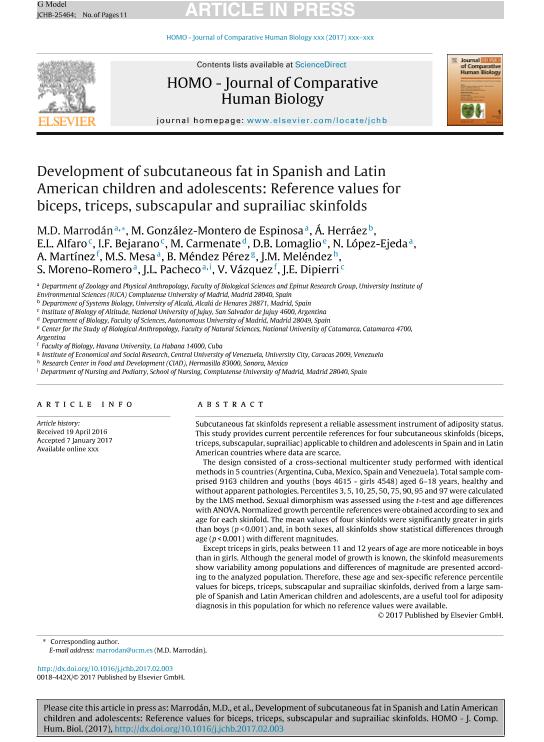Mostrar el registro sencillo del ítem
dc.contributor.author
Marrodán, María Dolores

dc.contributor.author
González Montero de Espinosa, M.
dc.contributor.author
Herráez, Á.
dc.contributor.author
Alfaro Gómez, Emma Laura

dc.contributor.author
Bejarano, Ignacio Felipe

dc.contributor.author
Carmenate, M.
dc.contributor.author
Lomaglio, Delia Beatriz

dc.contributor.author
López Ejeda, N.
dc.contributor.author
Martínez, A.
dc.contributor.author
Mesa, M.S.
dc.contributor.author
Mendez Perez, B.
dc.contributor.author
Meléndez, J.M.
dc.contributor.author
Moreno Romero, S.
dc.contributor.author
Pacheco, J.L.
dc.contributor.author
Vázquez, V.
dc.contributor.author
Dipierri, Jose Edgardo

dc.date.available
2018-04-04T14:37:28Z
dc.date.issued
2016-04
dc.identifier.citation
Marrodán, María Dolores; González Montero de Espinosa, M.; Herráez, Á.; Alfaro Gómez, Emma Laura; Bejarano, Ignacio Felipe; et al.; Development of subcutaneous fat in Spanish and Latin American children and adolescents: Reference values for biceps, triceps, subscapular and suprailiac skinfolds; Elsevier Gmbh; Homo; 68; 2; 4-2016; 145-155
dc.identifier.issn
0018-442X
dc.identifier.uri
http://hdl.handle.net/11336/40659
dc.description.abstract
Subcutaneous fat skinfolds represent a reliable assessment instrument of adiposity status. This study provides current percentile references for four subcutaneous skinfolds (biceps, triceps, subscapular, suprailiac) applicable to children and adolescents in Spain and in Latin American countries where data are scarce.The design consisted of a cross-sectional multicenter study performed with identical methods in 5 countries (Argentina, Cuba, Mexico, Spain and Venezuela). Total sample comprised 9163 children and youths (boys 4615 - girls 4548) aged 6-18 years, healthy and without apparent pathologies. Percentiles 3, 5, 10, 25, 50, 75, 90, 95 and 97 were calculated by the LMS method. Sexual dimorphism was assessed using the t-test and age differences with ANOVA. Normalized growth percentile references were obtained according to sex and age for each skinfold. The mean values of four skinfolds were significantly greater in girls than boys (p <. 0.001) and, in both sexes, all skinfolds show statistical differences through age (p <. 0.001) with different magnitudes.Except triceps in girls, peaks between 11 and 12 years of age are more noticeable in boys than in girls. Although the general model of growth is known, the skinfold measurements show variability among populations and differences of magnitude are presented according to the analyzed population. Therefore, these age and sex-specific reference percentile values for biceps, triceps, subscapular and suprailiac skinfolds, derived from a large sample of Spanish and Latin American children and adolescents, are a useful tool for adiposity diagnosis in this population for which no reference values were available.
dc.format
application/pdf
dc.language.iso
eng
dc.publisher
Elsevier Gmbh

dc.rights
info:eu-repo/semantics/openAccess
dc.rights.uri
https://creativecommons.org/licenses/by-nc-sa/2.5/ar/
dc.subject
Subcutaneous Fat
dc.subject
Reference Values
dc.subject
Children
dc.subject
Adolescent
dc.subject.classification
Salud Ocupacional

dc.subject.classification
Ciencias de la Salud

dc.subject.classification
CIENCIAS MÉDICAS Y DE LA SALUD

dc.title
Development of subcutaneous fat in Spanish and Latin American children and adolescents: Reference values for biceps, triceps, subscapular and suprailiac skinfolds
dc.type
info:eu-repo/semantics/article
dc.type
info:ar-repo/semantics/artículo
dc.type
info:eu-repo/semantics/publishedVersion
dc.date.updated
2018-04-03T18:23:31Z
dc.journal.volume
68
dc.journal.number
2
dc.journal.pagination
145-155
dc.journal.pais
Alemania

dc.journal.ciudad
Stuttgart
dc.description.fil
Fil: Marrodán, María Dolores. Universidad Complutense de Madrid; España
dc.description.fil
Fil: González Montero de Espinosa, M.. Universidad Complutense de Madrid; España
dc.description.fil
Fil: Herráez, Á.. Universidad de Alcalá; España
dc.description.fil
Fil: Alfaro Gómez, Emma Laura. Consejo Nacional de Investigaciones Científicas y Técnicas; Argentina. Universidad Nacional de Jujuy. Instituto de Biología de la Altura; Argentina
dc.description.fil
Fil: Bejarano, Ignacio Felipe. Universidad Nacional de Jujuy. Instituto de Biología de la Altura; Argentina
dc.description.fil
Fil: Carmenate, M.. Universidad Autónoma de Madrid; España
dc.description.fil
Fil: Lomaglio, Delia Beatriz. Universidad Nacional de Catamarca. Facultad de Ciencias Exactas y Naturales. Centro de Estudios de Antropología Biologica; Argentina
dc.description.fil
Fil: López Ejeda, N.. Universidad Complutense de Madrid; España
dc.description.fil
Fil: Martínez, A.. Universidad de la Havana; Cuba
dc.description.fil
Fil: Mesa, M.S.. Universidad Complutense de Madrid; España
dc.description.fil
Fil: Mendez Perez, B.. Universidad Central de Venezuela; Venezuela
dc.description.fil
Fil: Meléndez, J.M.. Research Center in Food and Development ; México
dc.description.fil
Fil: Moreno Romero, S.. Universidad Complutense de Madrid; España
dc.description.fil
Fil: Pacheco, J.L.. Universidad Complutense de Madrid; España
dc.description.fil
Fil: Vázquez, V.. Universidad de la Havana; Cuba
dc.description.fil
Fil: Dipierri, Jose Edgardo. Universidad Nacional de Jujuy. Instituto de Biología de la Altura; Argentina
dc.journal.title
Homo
dc.relation.alternativeid
info:eu-repo/semantics/altIdentifier/doi/http://dx.doi.org/10.1016/j.jchb.2017.02.003
dc.relation.alternativeid
info:eu-repo/semantics/altIdentifier/url/https://www.sciencedirect.com/science/article/pii/S0018442X17300112
Archivos asociados
